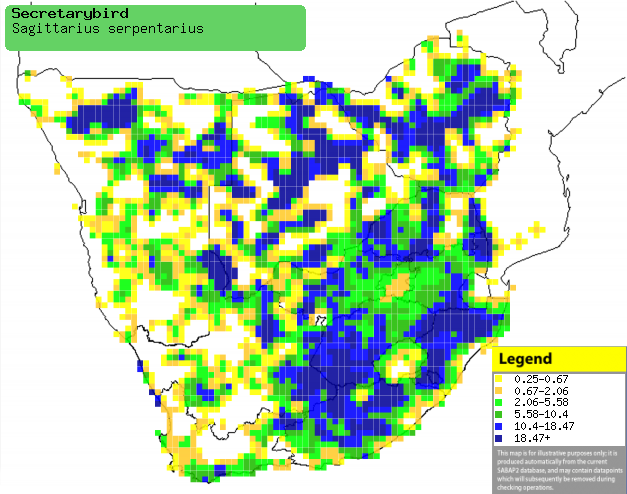|
Sagittarius serpentarius (Secretarybird)
Life
> Eukaryotes >
Opisthokonta
> Metazoa (animals) >
Bilateria >
Deuterostomia > Chordata >
Craniata > Vertebrata (vertebrates) > Gnathostomata (jawed
vertebrates) > Teleostomi (teleost fish) > Osteichthyes (bony fish) > Class:
Sarcopterygii (lobe-finned
fish) > Stegocephalia (terrestrial
vertebrates) > Tetrapoda
(four-legged vertebrates) > Reptiliomorpha > Amniota >
Reptilia (reptiles) >
Romeriida > Diapsida > Archosauromorpha > Archosauria >
Dinosauria
(dinosaurs) > Saurischia > Theropoda (bipedal predatory dinosaurs) >
Coelurosauria > Maniraptora > Aves
(birds) > Order: Falconiformes > Family: Sagittariidae
Distribution and habitat
Occurs across sub-Saharan Africa, excluding the lowland
forest of west Africa and the DRC. In southern Africa it is locally fairly common across much of the region, largely
excluding Mozambique. It generally prefers open grassland with scattered trees,
open Acacia and bushwillow (Combretum) savanna, shrubland, range
lands, airstrips and other habitats with short grass.
|
 |
|
Distribution of Secretarybird in southern Africa,
based on statistical smoothing of the records from first SA Bird Atlas
Project (©
Animal Demography unit, University of
Cape Town; smoothing by Birgit Erni and Francesca Little). Colours range
from dark blue (most common) through to yellow (least common).
See here for the latest distribution
from the SABAP2. |
Predators and parasites
It has been recorded as prey of
Bubo lacteus (Verreaux's
eagle-owl).
Movements and migrations
Resident and nomadic, especially in the arid
west.
Food
It mainly eats grasshoppers and small vertebrates,
typically hunting
by stamping its long legs on the ground to disturb prey, then
catching them with its bill. The following food items have been recorded in its
diet:
- Invertebrates
- Vertebrates
- reptiles
- small mammals
- birds
- amphibians
Breeding
- Monogamous, territorial solitary nester, performing a variety of displays
for defending its territory and courtship.
- The nest is built by both sexes, consisting of a large flat platform
about 1.0-1.5 metres wide, made of sticks and lined with grass. It is typically placed on top of a thorny tree, such as a
Black thorn (Acacia mellifera), Umbrella thorn (Acacia tortilis),
Sweet thorn (Acacia karroo), Common hook thorn (Acacia caffra)
or the alien Black wattle (Acacia mearnsii) and pine (Pinus).
The breeding pair roost in the structure for several months before breeding,
and may even use the nest for roosting only.
- Egg-laying season is year-round, peaking from April-May in Namibia but
from September-December elsewhere.
- It lays 1-3 eggs, which are mainly incubated by the female for about
40-46 days, while the male feeds her at the nest.
- The chicks are fed by both adults by regurgitation, and by the time the
reach 38 days old they can find food for themselves, yet they remain
dependent on their parents for food and water for another 25 days or so. The
young take their first flight at about 64-105 days old, but are still at
least partially dependent on their parents for a further 62-105 days,
sometimes returning to the nest to practice flying and kicking.
Threats
Not threatened, although local population decreases have
been reported in South Africa.
References
-
Hockey PAR, Dean WRJ and Ryan PG 2005. Roberts - Birds of
southern Africa, VIIth ed. The Trustees of the John Voelcker Bird Book
Fund, Cape Town.
|
